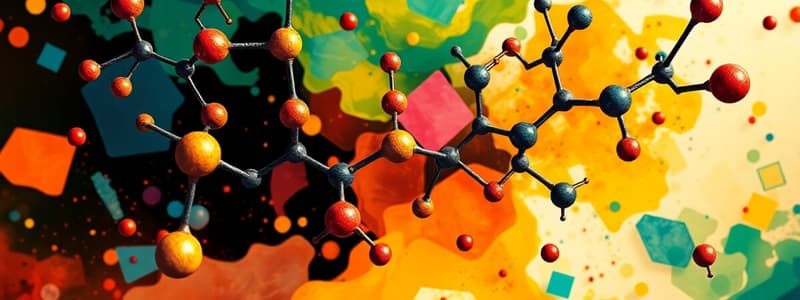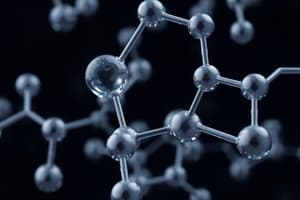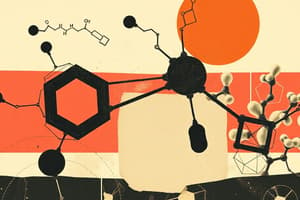Podcast
Questions and Answers
What is required to become a registered dietitian?
What is required to become a registered dietitian?
- Completion of a supervised internship program (correct)
- A master's degree in health sciences
- At least two years of work experience in a hospital
- Certification in personal training
What is the primary characteristic of lipids?
What is the primary characteristic of lipids?
- They are hydrophobic and insoluble in water (correct)
- They are produced exclusively by plants
- They are comprised solely of proteins
- They are polar molecules that dissolve in water
Which of the following is NOT a function of lipids in cells?
Which of the following is NOT a function of lipids in cells?
- Storing energy for long-term use
- Providing insulation from the environment
- Catalyzing biochemical reactions (correct)
- Serving as building blocks of hormones
Which components make up a triglyceride?
Which components make up a triglyceride?
What is the role of the carboxyl group in fatty acids?
What is the role of the carboxyl group in fatty acids?
Which type of lipid is specifically known for being a major component of cellular membranes?
Which type of lipid is specifically known for being a major component of cellular membranes?
Which of the following statements about fatty acids is true?
Which of the following statements about fatty acids is true?
How are the three fatty acids attached to the glycerol molecule in a triglyceride?
How are the three fatty acids attached to the glycerol molecule in a triglyceride?
What determines the chemical nature of an amino acid?
What determines the chemical nature of an amino acid?
What type of bond is formed between two amino acids?
What type of bond is formed between two amino acids?
Which statement best describes the difference between polypeptides and proteins?
Which statement best describes the difference between polypeptides and proteins?
What is the evolutionary significance of cytochrome c?
What is the evolutionary significance of cytochrome c?
How many amino acids are found in human cytochrome c?
How many amino acids are found in human cytochrome c?
What is the importance of the shape of a protein?
What is the importance of the shape of a protein?
Which amino acid comparison shows the most similarity indicating recent common ancestry?
Which amino acid comparison shows the most similarity indicating recent common ancestry?
What reaction type leads to the formation of peptide bonds?
What reaction type leads to the formation of peptide bonds?
What provides structural support to plant cells?
What provides structural support to plant cells?
Which type of animals can digest cellulose due to the presence of specific bacteria?
Which type of animals can digest cellulose due to the presence of specific bacteria?
What is the primary component of the exoskeleton in arthropods?
What is the primary component of the exoskeleton in arthropods?
How do glucosidic bonds in cellulose influence its properties?
How do glucosidic bonds in cellulose influence its properties?
What role does dietary fiber play as cellulose passes through the human digestive system?
What role does dietary fiber play as cellulose passes through the human digestive system?
What is a characteristic of polysaccharides like cellulose and chitin?
What is a characteristic of polysaccharides like cellulose and chitin?
What distinguishes cellulose from other carbohydrates such as starch and glycogen?
What distinguishes cellulose from other carbohydrates such as starch and glycogen?
Why are registered dietitians increasingly sought after regarding obesity-related diseases?
Why are registered dietitians increasingly sought after regarding obesity-related diseases?
Which function of proteins is specifically related to regulating physiological processes?
Which function of proteins is specifically related to regulating physiological processes?
What is an example of an enzyme mentioned in the provided content?
What is an example of an enzyme mentioned in the provided content?
How do changes in temperature and pH affect proteins?
How do changes in temperature and pH affect proteins?
What characteristic of proteins is critical to their function?
What characteristic of proteins is critical to their function?
What is the primary structural unit that makes up proteins?
What is the primary structural unit that makes up proteins?
Which of the following statements is true about the R group in amino acids?
Which of the following statements is true about the R group in amino acids?
What type of protein is hemoglobin considered to be?
What type of protein is hemoglobin considered to be?
What role do enzymes play in biochemical reactions?
What role do enzymes play in biochemical reactions?
What determines the primary structure of a protein?
What determines the primary structure of a protein?
Which protein structure is characterized by hydrogen bonding forming alpha helices and beta-pleated sheets?
Which protein structure is characterized by hydrogen bonding forming alpha helices and beta-pleated sheets?
How does the mutation causing sickle-cell anemia affect the hemoglobin structure?
How does the mutation causing sickle-cell anemia affect the hemoglobin structure?
What is the overall impact of the structural change in hemoglobin in sickle-cell patients?
What is the overall impact of the structural change in hemoglobin in sickle-cell patients?
What level of protein structure involves the arrangement of multiple polypeptide chains?
What level of protein structure involves the arrangement of multiple polypeptide chains?
Which of the following is NOT a common secondary structure of proteins?
Which of the following is NOT a common secondary structure of proteins?
Which statement best describes how changes in gene sequence might affect proteins?
Which statement best describes how changes in gene sequence might affect proteins?
What type of bond primarily stabilizes the secondary structure of proteins?
What type of bond primarily stabilizes the secondary structure of proteins?
What are the two main types of nucleic acids?
What are the two main types of nucleic acids?
Which statement accurately describes the role of RNA in cells?
Which statement accurately describes the role of RNA in cells?
What components make up a nucleotide?
What components make up a nucleotide?
What is the structural arrangement of DNA molecules?
What is the structural arrangement of DNA molecules?
Which part of the nucleotide contains the genetic information?
Which part of the nucleotide contains the genetic information?
How are the two strands of DNA bound together?
How are the two strands of DNA bound together?
What forms the backbone of the DNA structure?
What forms the backbone of the DNA structure?
In what way do the bases pair in DNA?
In what way do the bases pair in DNA?
Flashcards
Cellulose structure
Cellulose structure
Cellulose is a structural carbohydrate made of glucose monomers linked together in long chains. Every other glucose monomer is flipped, creating a rigid, strong structure.
Cellulose function
Cellulose function
Cellulose provides structural support to plant cell walls.
Dietary fiber
Dietary fiber
Cellulose that passes through our digestive system without being broken down.
Herbivore digestion of cellulose
Herbivore digestion of cellulose
Signup and view all the flashcards
Cellulase
Cellulase
Signup and view all the flashcards
Chitin
Chitin
Signup and view all the flashcards
Carbohydrate functions
Carbohydrate functions
Signup and view all the flashcards
Glucose monomers
Glucose monomers
Signup and view all the flashcards
Registered Dietitian
Registered Dietitian
Signup and view all the flashcards
Lipids
Lipids
Signup and view all the flashcards
Hydrophobic
Hydrophobic
Signup and view all the flashcards
Fat Molecule (Triglyceride)
Fat Molecule (Triglyceride)
Signup and view all the flashcards
Glycerol
Glycerol
Signup and view all the flashcards
Fatty Acid
Fatty Acid
Signup and view all the flashcards
Covalent Bond
Covalent Bond
Signup and view all the flashcards
Plasma Membrane
Plasma Membrane
Signup and view all the flashcards
Amino Acid R Group
Amino Acid R Group
Signup and view all the flashcards
Polypeptide vs. Protein
Polypeptide vs. Protein
Signup and view all the flashcards
Peptide Bond
Peptide Bond
Signup and view all the flashcards
Protein Shape and Function
Protein Shape and Function
Signup and view all the flashcards
Cytochrome c
Cytochrome c
Signup and view all the flashcards
Evolutionary Protein Comparison
Evolutionary Protein Comparison
Signup and view all the flashcards
What determines a protein's shape?
What determines a protein's shape?
Signup and view all the flashcards
How are peptide bonds formed?
How are peptide bonds formed?
Signup and view all the flashcards
Protein function
Protein function
Signup and view all the flashcards
Enzyme
Enzyme
Signup and view all the flashcards
Substrate
Substrate
Signup and view all the flashcards
Amino acid
Amino acid
Signup and view all the flashcards
Hormone
Hormone
Signup and view all the flashcards
Protein Shape
Protein Shape
Signup and view all the flashcards
Protein Denaturation
Protein Denaturation
Signup and view all the flashcards
R group
R group
Signup and view all the flashcards
Primary Protein Structure
Primary Protein Structure
Signup and view all the flashcards
Sickle Cell Anemia
Sickle Cell Anemia
Signup and view all the flashcards
Secondary Protein Structure
Secondary Protein Structure
Signup and view all the flashcards
Alpha (α)-Helix
Alpha (α)-Helix
Signup and view all the flashcards
Beta (β)-Pleated Sheet
Beta (β)-Pleated Sheet
Signup and view all the flashcards
Tertiary Protein Structure
Tertiary Protein Structure
Signup and view all the flashcards
Quaternary Protein Structure
Quaternary Protein Structure
Signup and view all the flashcards
Nucleic Acids
Nucleic Acids
Signup and view all the flashcards
DNA
DNA
Signup and view all the flashcards
RNA
RNA
Signup and view all the flashcards
Nucleotide
Nucleotide
Signup and view all the flashcards
Nitrogenous Base
Nitrogenous Base
Signup and view all the flashcards
Double Helix
Double Helix
Signup and view all the flashcards
Hydrogen Bonds
Hydrogen Bonds
Signup and view all the flashcards
Phosphate-Sugar Backbone
Phosphate-Sugar Backbone
Signup and view all the flashcards
Study Notes
Biological Molecules
- Biological macromolecules are large molecules essential for life, made from smaller organic molecules.
- Four major classes: carbohydrates, lipids, proteins, and nucleic acids.
- These molecules are organic, containing carbon bonded to hydrogen, and often including oxygen, nitrogen, and other minor elements.
Carbon's Importance
- Carbon is central to life because it forms the fundamental components of many molecules essential to living organisms.
- Carbon has four electrons in its outer shell, enabling it to form four covalent bonds with other atoms or molecules.
- This versatility allows for the formation of complex molecules such as methane (CH4), a simple molecule and the basis of many more complex ones.
Carbohydrates
- Carbohydrates are important for energy and other functions.
- Classified into monosaccharides, disaccharides, and polysaccharides.
- Monosaccharides (e.g., glucose) are simple sugars with a formula of (CH2O)n, where n is the number of carbon atoms.
- Disaccharides consist of two monosaccharides joined together.
- Lactose = glucose + galactose
- Sucrose = glucose + fructose
- Maltose = glucose + glucose
- Polysaccharides are long chains of monosaccharides. Examples include starch (plants), glycogen (animals), and cellulose.
Lipids
- Lipids are a diverse group of nonpolar molecules including fats, oils, waxes, phospholipids, and steroids.
- They are hydrophobic ("water-fearing") due to hydrocarbon chains, and because of this, are important for energy storage and insulation.
- Fats (Triglycerides) are composed of glycerol and fatty acids. Fatty acids can be saturated (single bonds) or unsaturated (contain double bonds).
- Unsaturated fatty acids are often liquid at room temperature ("oils").
- Saturated fatty acids are often solids at room temperature ("fats").
Proteins
- Proteins perform a wide range of functions in living organisms.
- Proteins are polymers of amino acids. There are 20 different amino acids.
- The type and order of amino acids determine the protein's shape and function.
- Proteins have four levels of structure:
- Primary: The unique sequence of amino acids in a polypeptide chain.
- Secondary: Local folding of the polypeptide chain, often into alpha-helices or beta-sheets.
- Tertiary: The three-dimensional structure of a polypeptide chain.
- Quaternary: The arrangement of multiple polypeptide chains in a protein.
Nucleic Acids
- Nucleic acids (DNA and RNA) store and transmit genetic information.
- Nucleic acids are polymers of nucleotides.
- Each nucleotide has three parts: a nitrogenous base, a pentose sugar, and a phosphate group.
- DNA: A double helix, with nucleotides paired via hydrogen bonds (A-T and C-G)
- RNA: A single-stranded molecule and differs structurally from DNA. It plays a role in protein synthesis.
Studying That Suits You
Use AI to generate personalized quizzes and flashcards to suit your learning preferences.




